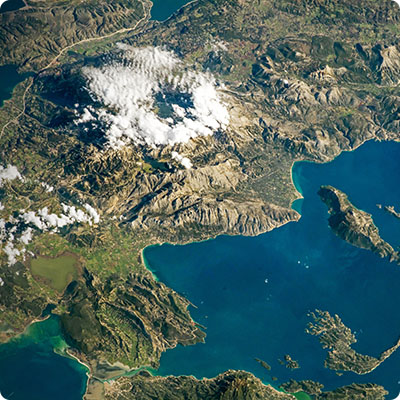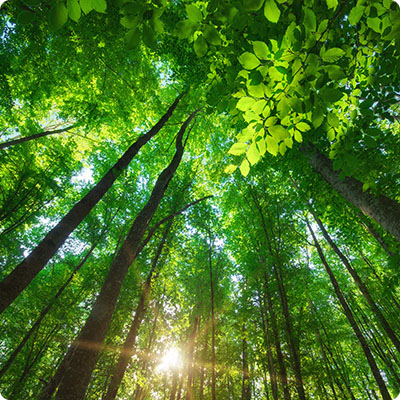Flore
The island is home to 15,000 plant species and around 3,000 different tree species. The tropical forests are made up of several layers, each with its own specific vegetation, with canopies up to 36 meters high and trees of imposing size. The Shorea faguetiana specimen in Tawau Hills National Park, 88.30 meters high, is one of the tallest trees in the world. Borneo is also home to over 1,700 species of orchid, some of which are extremely rare. Borneo is also home to the world's largest flower, the rafflesia (Rafflesia arnoldii), which can grow to almost a metre in diameter and weigh up to 10 kg. Carnivorous plants are another astonishing feature of tropical forests, and the island boasts over 50 species. The most remarkable is the Bornean Nepenthes, a vase-shaped plant whose receptacle contains a liquid that attracts insects and a lid that closes to capture them. You can catch a glimpse of this plant on your climb up Mount Kinabalu.
Fauna
Orangutan. A true icon of the island, the Bornean orangutan (Pongo pygmaeus) is the only great ape native to Asia, along with the Sumatran orangutan (Pongo abelii) and the Tapanuli orangutan(Pongo tapanuliensis) in Indonesia. The orangutan, whose name means "Man of the Forest" in Malay, shares 97% of its DNA with humans and lives almost exclusively in trees. Each day, it builds a bed in the canopy using foliage and branches to spend the night. Males weigh an average of 75 kg, while females weigh around 38 kg. Orangutans have grayish skin with a heavy reddish coat that does not cover their chubby faces. In the wild, orangutans live between 35 and 40 years, while individuals in captivity or in rehabilitation centers can reach up to 60 years of age.
There are still 104,700 orangutans in the island's tropical forests, but the species is greatly threatened by the destruction of its habitat by logging companies, and is also a victim of poaching. According to WWF(www.worldwildlife.org/species/bornean-orangutan), "Bornean orangutan populations have declined by more than 50% over the past 60 years, and the species' habitat has been reduced by at least 55% over the past 20 years". Several orangutan rehabilitation projects have been set up in Borneo, including the Sepilok Orangutan Rehabilitation Centre in Sabah, the Semenggoh Wildlife Centre near Kuching in Sarawak, and the Borneo Orangutan Survival Foundation in East Kalimantan Tengah. At these centers, it's not uncommon to observe apes feeding. Ideally, of course, you should admire the orangutan in its natural jungle habitat, but it's more difficult to catch a glimpse of it as it tends to perch high in the trees, fleeing human presence to protect itself.
Nasalis monkey. The nasic monkey (Nasalis larvatus) is the other star of the island. It lives only in Borneo and takes its name from its imposing nasal appendage, which serves as a seductive tool. Only the male has a long nose, which can sometimes extend below his chin; females have a much smaller appendage, making them easily distinguishable. Quite small compared to the orangutan (average length 70 cm), the nose ape is also an arboreal species. Its nasal appendage is also used to amplify its calls, which can be heard throughout the jungle, notably to warn other orangutans of impending danger. They live in groups, sometimes cohabiting with other monkey species. Only 7,000 individuals remain on the island, this species being threatened with extinction for the same reasons as the orangutan. It is a common sight in Sarawak's Bako National Park, along the banks of the river in Sabah's Kinabatagan sanctuary, in the mangroves near Bandar Seri Begawan in Brunei, or in Kalimantan Tengah's Tanjung Puting National Park. There's also a private rehabilitation center in Sepilok (Sabah): the Labuk Bay Proboscis Monkey Sanctuary.
The island's forests are also home to a variety of monkey species. Among the most remarkable are the gibbon, the silver leaf monkey, the red leaf monkey and the long-tailedmacaque. There is even a mysterious monkey thought to be the rare result of a cross between a nasic and a red leaf monkey!
Bornean elephant. A subspecies of the Asian elephant, the Borneo elephant is smaller, hence its nickname of pygmy elephant or dwarf elephant. However, it is the same size as the elephants of peninsular Malaysia... Their population on the island is estimated at around 1,500 individuals, concentrated in the states of Sabah and North Kalimantan. Seeing a herd of elephants is one of the major objectives of nature-loving travellers. In Sabah, you'll have the opportunity to observe them around the Kinabatagan River and in the Deramakot ForestReserve. They differ from Asian elephants in their passive, docile behavior, which some scientists believe confirms their domestic origin. In fact, two theories have been put forward: either they are indigenous to Sunda, a country formerly attached to the peninsula, or they are the descendants of elephants introduced by the Sultan of Sulu and whose population then spread. In those days, an elephant was a prestigious gift for a sultan. The absence of elephants in traditional Dayak art and its concentration in the north of the island tend to confirm the latter hypothesis. The Bornean elephant is an endangered species, facing deforestation and habitat destruction, as well as poaching, hunters and human-elephant conflicts near villages.
Bats (Chiroptera) make up the largest mammal population on the island, with no fewer than 102 different species! The most famous are the Bornean fruit bat and the Malayan fruit bat. You'll see them in great numbers in caves, particularly in the magnificent Gunung Mulu National Park in Sarawak.
The Malayan bear (Helarctos malayanus) is the smallest of the world's eight bear families. It can sometimes be spotted in the forest early in the morning, when it goes in search of food. The Bornean Sun Bear Conservation Center in Sepilok (Sabah), a center dedicated to the preservation of the species, is the best place to see it. Other mammals to be seen in the forest include the fascinating clouded leopard, Bornean golden cat, marbled cat, sambar, yellow muntjac deer, red flying squirrel, colugo, civet, mongoose, otter, whiskered boar, binturong, a large number of rodents..
Rhinoceros hornbill. The emblem of the Malaysian state of Sarawak, the rhinoceros hornbill (Buceros rhinoceros) is a large bird that owes its name to its imposing, curved orange helmet. It plays an important role in Dayak tradition, and is often depicted in sculptures and fabric designs. There are seven other species of hornbill on the island, including the crested hornbill, recognizable by its white headdress, the round-headed hornbill, the coal hornbill and the scalloped hornbill. The hornbills' natural habitat is also seriously threatened by the conversion of forests to palm groves. In addition to hornbills, Borneo is home to 420 bird species, including 18 types of woodpecker. 37 bird species are endemic to the island, including two species found only in Borneo: the black-browed akalat and Strickland's shama.
Sea crocodile (Crocodylus porosus). This crocodile lives in both freshwater rivers and brackish estuaries. It is one of Borneo's " Big Five " must-see animals, along with the orangutan, the nose ape, the Bornean elephant and the rhinoceros hornbill. Also known as the saltwater crocodile, it is found in large numbers along the Kinabatagan River and in the island's estuaries. It is the world's largest crocodile species, along with the Nile crocodile, and can measure up to 6 meters in length and weigh up to a ton! This dangerous predator poses a threat to humans, and especially to local populations who venture into the waterways to fish. Attacks on humans are frequent, so if you're on a boat cruise, we strongly advise you not to leave your hands in the water...
Reptiles and amphibians. In addition to the marine crocodile, you'll find its cousin the gharial or Ganges gharial, a long-snouted freshwater crocodile, 105 species of lizards such as the Bronchocela cristatella, or the Draco quinquefasciatus with its dragon-like wings, various kinds of snakes, turtles and 180 species of amphibians, including one of the world's smallest frogs.
Bornean rhinoceros. This is a subspecies of the Sumatran rhinoceros, the smallest of the rhinos. Experts considered this species extinct in Borneo, but in 2016 a small population of around 15 individuals was discovered in East Kalimantan. The Sumatran rhinoceros once roamed the foothills of the eastern Himalayas in Bhutan and Southeast Asia. Smaller than the African rhinoceros, the Sumatran rhinoceros is also known as the two-horned rhinoceros and has long hair. Today, the Sumatran rhinoceros is threatened with extinction, due to the destruction of its natural habitat and poaching (for its horn). The species has totally disappeared from its natural habitat in Malaysia (Peninsular Malaysia and the Borneo states of Sarawak and Sabah), and only survives in small numbers on the Indonesian island of Sumatra and in Kalimantan, Borneo.
Malayan pangolin. The Malayan pangolin (or Javanese pangolin) is distinguished from the Chinese pangolin by its slimmer body and longer tail. The world's only mammal carapached with solid keratinous scales, this creature is capable of curling up into a ball when it feels threatened. The pangolin plays a vital role in the balance of the tropical forest ecosystem, as it is a major consumer of insects, ants and termites. This type of anteater, which can measure from 30 to 80 cm and weigh up to 30 kg, is unfortunately classified as critically endangered. In fact, the pangolin holds the sad record of being the world's most poached and illegally traded mammal! It is much sought-after by traffickers for its scales, which are said to have numerous virtues according to traditional Chinese and Vietnamese medicines, as well as for its meat, which is said to have healing powers and improve virility. As a result, it is sold at a premium on the black market in China and Vietnam. Its disappearance from the forests of Borneo would further destabilize an already fragile ecosystem.
Bornean tiger. Incredible as it may seem, there were tigers in Borneo! Smaller than its Indian cousin, the tiger lived on the island in prehistoric times. Numerous bone fragments have been found, notably in Sarawak's Niah National Park. Today, this species exists only in Dayak folklore, although some communities still claim to spot it in the jungle from time to time..
Marine life. Borneo boasts some of the finest seabed in the world, particularly around the islands of the Semporna archipelago in the eastern state of Sabah. Borneo boasts 91 different species of marine mammals. The green turtle regularly lays its eggs on the islands of Turtle Islands National Park. Other interesting animals include the Irrawaddy dolphin, the very rare Borneo shark(Carcharhinus borneensis), the dugong, the whale... And of course a large number of types of fish such as barracuda, clownfish, skate..















